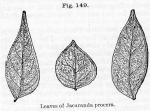Jacaranda.—Jacaranda.
 The leaves of Jacaranda procera, Sprengel (Jacaranda Caroba, De Candolle; Bignonia Caroba, Velloso; Bignonia Copaia, Aublet; Karadelestris syphilitica, Arruda da Camara).
The leaves of Jacaranda procera, Sprengel (Jacaranda Caroba, De Candolle; Bignonia Caroba, Velloso; Bignonia Copaia, Aublet; Karadelestris syphilitica, Arruda da Camara).
Nat. Ord.—Bignoniaceae.
COMMON NAMES: Carob-tree, Caroba, Caaroba.
Botanical Source.—The caroba tree grows in Guiana and Brazil, and attains a height of 30 or 40 feet. The tree is much branched, and luxuriantly crowned with a foliage of beautiful deep-green, compound leaves. These are abruptly bipinnatifid, dividing into 3 or 4 pairs of pinnae, each having from 8 to 12 elliptical, nearly sessile leaflets, subacute at each extremity, and covered underneath with a woolly pubescence, due to the abundance of long, empty hairs. The flowers are borne in terminal cymes, are white and red and showy, and exhale a honey-like perfume. The fruit is a woody, many-seeded capsule. The root of the tree is deep-red externally, and yellow-white internally. The bark of the tree is of an ashen hue.
Description and History.—The leaves are the medicinal parts. They are somewhat coriaceous, from 1 to 2 inches long, entire or nearly so, elliptic, lance-oblong, or oblong; either oblique at base, or subacute at both extremities, smooth, and dark-brown on upper surface, lighter beneath, strongly nerved, and velvety-woolly. The surfaces are beset with oil-glands. Odor slight; taste bitter-astringent.
The Jacaranda procera is one of the many trees known in Brazil as Caroba or Carobinha, others being Jacaranda oxyphylla, Chamisso; Jacaranda brancha, Sprengel; Jacaranda subrhombea, De Candolle; Caroba de flor verde, Sprengel; Bignonia nodosa, Manso; Sparottosperma lithontripticum, Martius; Cybistax antisyphilitica, Martius—all of them having uses similar to jacaranda in their native country.
Chemical Composition.—A detailed analysis of the leaves and bark of Jacaranda procera, by Th. Peckolt (Zeitschr. d. Oesterr. Apoth. Ver., 1881, Nos. 30 and 31), is abstracted in Amer. Jour. Pharm., 1882, p. 135. The leaves contain carobin (0.16 per cent), a crystallizable, faintly bitterish, inodorous principle, soluble in boiling water and alcohol, insoluble in ether, precipitated from aqueous solution by tartar emetic; with acetic acid it yields a crystallizable compound. Carobic acid (0.05 per cent) crystallizes in needles of aromatic odor and acid taste; is soluble in water and diluted alcohol; steocarobic acid (0.10 per cent), pale-brown, of a tonka-like odor, soluble in cold absolute alcohol and ether; carobone (2.66 per cent), a balsamic, resinous acid, greenish, soluble in alcohol (sp. gr., 0.815) and caustic alkalies; caroba resin (3.33 per cent), inodorous and tasteless; caroba balsam (1.44 per cent), dark brown, syrupy, of tonka-like odor; caroba tannin (0.44 per cent), and a bitter principle (2.88 per cent); albumen, starch, etc. The bark contains carobin (0.3 per cent), caroba resin (0.5 per cent), the bitter principle (0.28 per cent), and in addition carobaretic acid (0.2 per cent), devoid of odor. According to Hesse (1880), no alkaloid is present.
Action, Medical Uses, and Dosage.—This agent has been used in its native country as an antisyphilitic, and was introduced into general medicine for the treatment of venereal disorders. If useful at all in syphilis, it appears to be endorsed as a remedy for secondary manifestation, and is used both locally and internally in syphilitic ulcerations. It has not been generally used by Eclectics for this purpose. It seems to have been successful in cystic disorders with pus-bearing and fetid urine, and in gonorrhoea. Carobin, which resembles the active constituent of sarsaparilla, has been used in doses of 1 grain in syphilis and scrofula (Peckolt). Dr. Lyman Watkins (Ec. Med. Jour.), treated successfully with jacaranda a case of epilepsy at the Eclectic Medical Institute Clinic. The disease was of fourteen years duration, and averaged from 7 to 10 convulsions in a day. From the very outset, through the 3 months during which the patient was treated, not a convulsive attack was experienced. Jacaranda undoubtedly has an influence upon the nervous structures. Epileptic disorders relieved by it are those superinduced by sexual indiscretions. It is recommended for those of feeble mentality though well-nourished in body, with voracious appetite and addicted to masturbation. The usual manner of exhibiting the remedy is as follows: Rx Specific jacaranda, flʒi or flʒii; aqua, fl℥iv. Mix. Sig. Teaspoonful. every 4 hours. Fluid extract of jacaranda is given in doses of from 15 to 30 minims, 4 times a day, carobin, in 1-grain doses. For local use, Rx Jacaranda leaves (powdered), ʒi to ʒii; petrolatum, ʒi.
Specific Indications and Uses.—Mental enfeeblement, voracious appetite, and epilepsy, particularly of masturbators; secondary syphilis and syphilitic ulcers.

